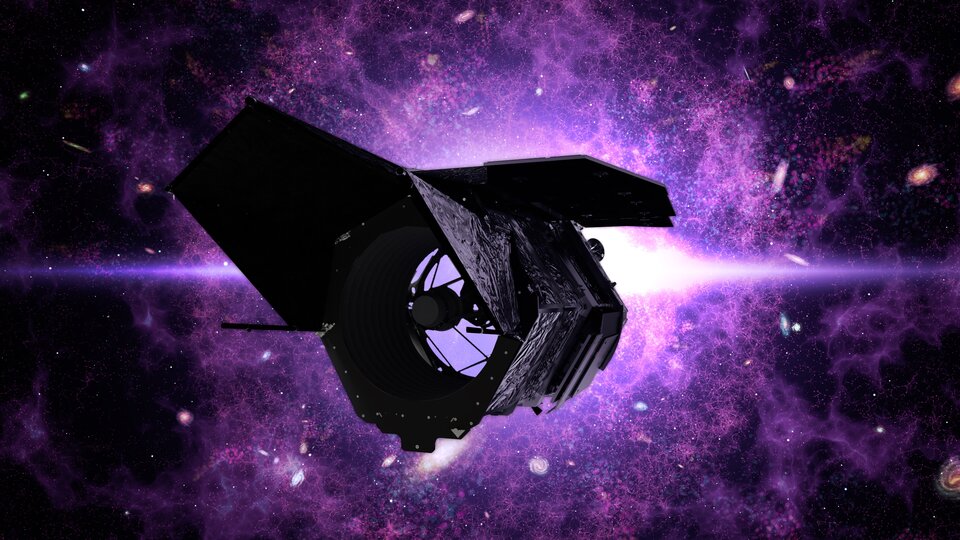Downlinking satellite data from space to the cloud
In October 2024, NASA and ESA carried out a series of system trials to test the transmission of data from ESA ground stations to commercial cloud servers.
Ground station operators at ESA’s space operations centre are preparing for their next major challenge: transmitting back to Earth the data from NASA's future Nancy Grace Roman Space Telescope.
The Nancy Grace Roman Space Telescope, scheduled for the second half of 2026, is expected to downlink an unprecedented amount of data: 500 Mb/s at the highest rate, six times more than ESA's Euclid mission, which currently holds the record at 75 Mb/s for a mission located at the Sun-Earth Lagrange 2 Point.
To tackle the Herculean task of collecting this huge flood of data, NASA, the European Space Agency, and the Japan Aerospace Exploration Agency are putting together the K-band capabilities of their deep-space antennas. ESA will provide support from the New Norcia 3 antenna, which will be completed in the second half of 2025.
In October 2024, NASA and ESA carried out a series of system trials to test the transmission of such a stream of data to ESA ground stations and its transfer to the cloud service provider selected by NASA.
A new model for satellite data distribution

The use of cloud-based solutions to gather the data offers a completely different paradigm compared to the approches of current space telescopes.
Currently, space telescopes- like Euclid or James Webb - do not make use of cloud facilities. Once downlinked, files are reconstructed at each ground station and transferred centrally – in the case of Euclid, it is ESOC - from where they are made available to the community.
For the Nancy Grace Roman Space Telescope, the communication infrastructure will be simplified. Each ground station’s purpose will demodulate the signal, decode the data, store the telemetry in files, and upload them to the nearest server (or “point of presence”).
“The test performed at ESOC went successfully. We managed to handle our share of data and transfer them of cloud servers. At the other end of the process, NASA handled the files within the Cloud and reconstructed them successfully,” explains Holger Dreihahn, Head of the Backend Software Section at ESOC.
“As expected, for the moment, our connectivity does not match Roman’s expected 500 Mb/s data rate. We are currently ongoing works to increase our speed from 200Mbit/s to 500Mbits/s and more.”
A first step for future missions
Cloud-based solutions are being explored at ESA to store and share various type of telemetry data. This type of solution is already being used by NASA to share Earth observation data.
“This activity is another step in our evolution towards a more cloud-based environment for ESA's operations, and we will gain valuable experience of commercial provider usage as a spillover of our work on the Nancy Grace Roman Space Telescope,” says Holger.
A part of a larger collaboration
ESA will provide support from its future New Norcia 3 antenna, located in Western Australia. This new antenna will supplement the three current deep-space antennas in ESA's global ground station network (Estrack). New Norcia 3 will play a pivotal role in the science downlink of Nancy Grace Roman Space Telescope and other ESA missions and is expected to be completed in the second part of 2025.
The European Space Agency will also contribute to the mission's detectors for the coronagraph instrument, star trackers and batteries.


Access the video














 Germany
Germany
 Austria
Austria
 Belgium
Belgium
 Denmark
Denmark
 Spain
Spain
 Estonia
Estonia
 Finland
Finland
 France
France
 Greece
Greece
 Hungary
Hungary
 Ireland
Ireland
 Italy
Italy
 Luxembourg
Luxembourg
 Norway
Norway
 The Netherlands
The Netherlands
 Poland
Poland
 Portugal
Portugal
 Czechia
Czechia
 Romania
Romania
 United Kingdom
United Kingdom
 Slovenia
Slovenia
 Sweden
Sweden
 Switzerland
Switzerland


























